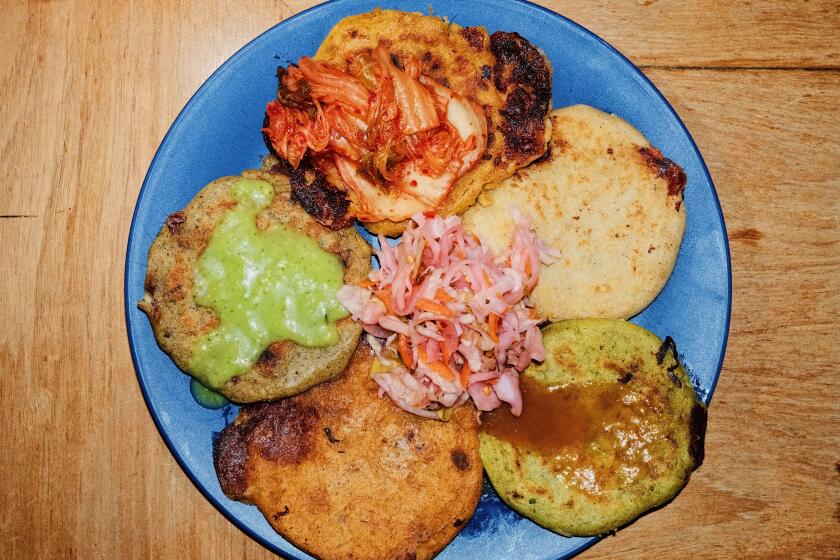Project Quiche : They Tap Gourmet Sources in Collecting Food for Poor
Sunny Angen’s home is typical Beverly Hills--bougainvillea and two gunmetal blue Mercedes draped in the driveway. Inside, Spanish paving tiles accent the tasteful entry hall. But on any Wednesday, the floor is all but obscured by piles of grocery sacks, boxes of vegetables and fruits, bags of breads.
It looks like the fixings for a party for her husband’s clients, but it’s not. The food is the would-be spoils of posh Beverly Hills bakeries, delicatessens, restaurants and markets. Angen and another Beverly Hills homemaker, Patty Myers, who used to enter those fancy eateries only by the front door to “do lunch,” now slip in through the delivery entrances in the alleys to collect food for the poor and hungry. Weekly, they truck the hundreds of pounds of gourmet food to shelters for the homeless and AIDS hospice patients.
“We live in the middle of all this affluence and see hungry people. This just shouldn’t be,” said Angen, 38, explaining why three months ago they started Project: Let’s Help.
Less than a week after surgery to repair a knee dislocated during aerobics class, Angen was hobbling into Cafe Roma. Owner Gigi Orlando prepares the food shortly before they arrive. “I don’t like the leftover idea. They should have only the freshest food. It is a good thing that they do,” Orlando said, heaping cartons of still warm pasta into their arms.
At Old World Restaurant, the women, wearing pink sweat shirts emblazoned with their logo, got two large containers of gourmet oatmeal laced with berries and raisins, and at Carl’s Market they retrieved macaroni and cheese, barbecued ribs, meat loaf and rice pilaf. At Morry’s Fine Foods, Irv Roman gave them several boxes of fruits and vegetables he previously would have marked down. At Nagila Pizza, Eli Nitka handed over several large pizzas and pasta salads. “It feels so much better to give the food to their project. We used to throw it away,” he said.
In one parking lot they were stopped by Bobbi Ross, a local real estate agent, curious about their trunkload of goods. They told her about the project, and Ross offered to help. They have several other volunteers who help with deliveries, and they would like to expand so that more food can be provided to agencies.
Met Through Husbands
The two women met through their husbands, Mark Myers, a lumber company executive, and accountant Larry Angen, who are business acquaintances. The women’s children (Angen has two, Myers three) are older, and they found chunks of spare time. Angen, who once owned an executive gift business, had been involved in various charities over the years. They volunteered at a soup kitchen and did work at a referral agency.
“But we didn’t feel we were really needed,” Myers said. “At the soup kitchen, there were already enough volunteers, and at the other, we sat for hours with nothing to do.”
One night, Angen was dining out and asked the owner if they had much food left at the end of the day. He said there was usually some left, which they threw away. Angen began plotting. Soon they went door to door to line up food donors, and then found three recipients: Park Community Center in Santa Monica, Gramercy Place Shelter near downtown and City of Angels Hospice in Hollywood.
The women have found that while many merchants in the glitziest shopping district in America have hearts of gold to match their pocketbooks, others are not so altruistic. On their list of donors, there is a glaring absence of “name” restaurants.
Some owners have told them that they have no leftover food; others say they fear they would be sued if the food turned bad.
A state law that went into effect this year limits a food facility’s civil and criminal liability if injury occurs from consuming donated food. However, restaurants and organizations distributing the food must still adhere to food handling safety standards, county health officials said.
‘That’s What It Is For’
Project: Let’s Help has been more rewarding than expected, Angen and Myers said. One day recently they were unloading tins when a transient asked for a piece of chicken. “I told him, ‘Of course. That’s what it is for,’ ” Angen recalled. “He said it had been so long since he had tasted fried chicken that he couldn’t remember what it tasted like.”
Stacy Schummer, a social worker at Park Community Center, said the center uses about 3,000 pounds of food a week, mostly staples and canned goods obtained from food banks and other organizations. “The food from Project: Let’s Help is always something special, like the sweets and homemade breads that we wouldn’t get otherwise,” she said.
Jim Bell, director of the nonprofit City of Angels Hospice, said the facility’s grocery bill of more than $1,000 a month has been reduced to less than $200 because of Angen and Myers.
“Our clients love it--the melons, fresh-squeezed orange juice, fancy meals. It is touches like that which makes this a home for them. It is a type of food we could never have given them, and it has made a great difference in their quality of life.”
More to Read
Eat your way across L.A.
Get our weekly Tasting Notes newsletter for reviews, news and more.
You may occasionally receive promotional content from the Los Angeles Times.










